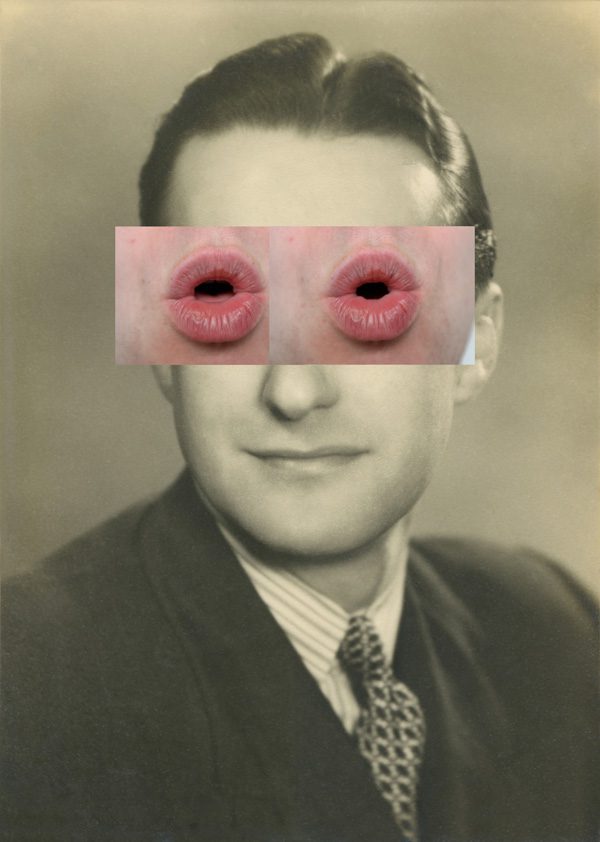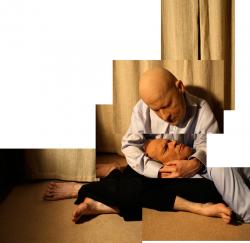Tanja Deman (Croatia)and Jonny Briggs (London) are contemporary, cutting edge artists that use photographic techniques as a vehicle to explore the themes of Family and Environment.
They operate and think in different ways…but there are similarities in the way they construct their outcomes, and have their roots in Dadaism, Surrealism and at times Fine Art, Documentary and Narrative photography. They also use archival imagery as an integral part of their practice, and cross reference psychology, psycho-analysis and philosophy too.
We will spend time exploring the background, history and theory of these approaches and creating imagery, film and more that embraces the methods of composite imagery, photo-collage and cut-n-paste.
Jonny Briggs
Jonny Briggs | Artist statement
“In search of lost parts of my childhood I try to think outside the reality I was socialised into and create new ones with my parents and self.
Through these I use photography to explore my relationship with deception, the constructed reality of the family, and question the boundaries between my parents and I, between child/adult, self/other, nature/culture, real/fake in attempt to revive my unconditioned self, beyond the family bubble.
Although easily assumed to be photo-shopped or faked, upon closer inspection the images are often realised to be more real than first expected. Involving staged installations, the cartoon-esque and the performative, I look back to my younger self and attempt to re-capture childhood nature through my assuming adult eyes.”
Tanja Deman
Tanja Deman | Artist statement
Tanja Deman’s art is inspired by her interest in the perception of space, physical and emotional connection to a place and her relationship to nature.
Tanja’s works, incorporating photography, collage, video and public art, are evocative meditations on urban space and landscape.
Observing recently built legacy or natural sites her work investigates the sociology of space and reflects dynamics hidden under the surface of both the built and natural environment.
https://vimeo.com/20713908
You must look at and follow Jonny (link here) and Tanja’s (link here) websites and social media outlets…
Twitter – Facebook – Instagram – Pinterest
LINK TO ARCHISLE FACEBOOK PAGE / JONNY BRIGGS INTERVIEWS
https://www.facebook.com/ArchisleJersey/
You can also use these links to explore the concept and theme of Family and Environment as tackled by previous students…
https://hautlieucreative.co.uk/photo17a2e/
https://hautlieucreative.co.uk/photo17a2/
TASK 1 Intro Blog Post
Create a blog post that reviews your experience of the day at Societe Jersiaise on Tuesday 13th June 2017.
- what did you see, understand and learn?
- what were the main talking points?
- include your images and experiments from the tasks, and outline the process and intentions
- Karen Biddlecombe / Gareth Syvret (Chief Archivist)Communications Assistant (part-time Mon, Weds, Thurs)Archisle: Jersey Contemporary Photography Programme
Société Jersiaise
7 Pier Road
St Helier
Jersey
JE2 4XW
Task 2 Create an extended blog post that shows a detailed description, analysis and interpretation of Jonny Brigg‘s work.
Aim to focus on 1 key example of his work and use FORMAL ANALYSIS techniques as a starting point only.
think about and discuss the content, concept, context, construction, composition, camera, then compare, contrast and critique
ask yourself ( and Jonny) what ? / why? / how?
You must define the process and include examples of Jonny’s presentation devices eg publications and exhibitions and show clearly how Jonny is influenced and and inspired by at least 2 of these artists…
| John Stezaker |
Tony Oursler |
Urs Fiscer |
Greta Alfaro |
| Cat Roissetter |
Alma Kaser |
Gillian Wearing |
Rene Magriette |
| Mike Keller |
Richard Billingham |
Noemie Goudal |
Paul Nouge |
| Gregor Schnieder |
Julie Cockburn |
Sarah Jones |
George Condo |
| Annette Messager |
Gabriella Boyd |
Thomas Demand |
Gordon Matta Clark |
| Joana Piotronska |
Kate Lyddon |
Henry Darger |
|
| Cindy Sherman |
Louise Bourgeoise |
Francis Bacon |
|
Remember to MAKE YOUR BLOG POST VISUAL
include relevant links, podcasts, videos where possible
Task 3 Create an extended blog post that shows a detailed description, analysis and interpretation of Tanja Deman‘s work.
Aim to focus on 1 key example of her work and use FORMAL ANALYSIS techniques as a starting point only.
think about and discuss the content, concept, context, construction, composition, camera, then compare, contrast and critique
ask yourself ( and Tanja) what ? / why? / how?
You must define the process and include examples of Tanja’s presentation devices eg publications and exhibitions and show clearly how Tanja is influenced and and inspired by at least 2 of the following artists…
Robert Adams // David GoldBlatt // Thomas Struth // Super Studio // Luigi Ghirri // Richard Misrach // Werner Herzog // Richard Long // Raymond Meeks // Antonioni // Alain Resnais // Katrin Koenning // Andrei Tarkovsky
Remember to MAKE YOUR BLOG POST VISUAL
include relevant links, podcasts, videos
YOU MUST HAVE THE FOLLOWING TASKS READY BY TUESDAY 20TH JUNE
- 5 x images of your own (DIGITAL): showing what aesthetics most interest them (all placed in 1 folder named
” MY IMAGES”, pictures named 1-5)
- 5 x images from the SJ archive (DIGITAL): in relation to the shooting location on Tuesday, Jersey cliffs, bunkers,
race tracks (all placed in 1 folder name 2. ARCHIVE IMAGES, pictures named 1-5)
- Research on artists references (images placed in 1 folder named 3 ARTISTS REFERENCES, pictures named with the artist’s name)
For an easier work flow in regards to the number of students each student should have a folder on their desktop
called ‘Photo collage workshop 20-27.6.’, with sub-folders inside named:
‘1. MY IMAGES’ (it should contain 5 images)
‘2. ARCHIVE IMAGES’ (it should contain 5 images)
‘3. ARTISTS REFERENCES’ (it should contain 5 images)
‘4. RAW PHOTOS’ (empty)
‘5. NEW WORK’ (empty)
Deadline for Completion
MONDAY 19TH JUNE
Extension Task 1
Research and define the following terms in photography to show an understanding of the influences, concept, history and theory in contemporary photography. Include key examples and try to show how they may have influenced Jonny and Tanja in some way.
Dadaism
Surrealism
Documentary and Narrative photography (visual storytelling)
Fine Art Photography
Extension Task 2
Tanja is clearly inspired and informed by her prior studies in architecture, natural forms, structures and sculpture.
During her SJ presentation she referred to
- Brutalist architecture
- Modernist architecture
Research, describe and explain what these forms of art are including how they came to prominence, where they can be found and what their legacy / influence is.
Where is there evidence of modernism / brutalism in Jersey?
Remember to include images, hyperlinks, videos etc



































































